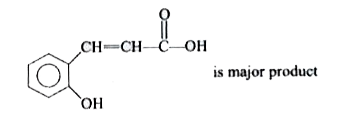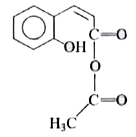(Z) -3- bromo -3- hexene when treated with CH3O− in CH3OH gives
3 - hexyne
2 - hexyne
2, 3 - hexadiene
2, 4 - hexadiene
The correct Answer is:A
To solve the question regarding the reaction of (Z)-3-bromo-3-hexene with CH₃O⁻ in CH₃OH, we can follow these steps:
Step 1: Identify the Structure of (Z)-3-bromo-3-hexene
- (Z)-3-bromo-3-hexene has a double bond at the 3rd carbon, with a bromine atom attached to the same carbon. The structure can be represented as follows:
CH3−CH2−C(Br)=C(CH3)−CH2−CH3
- The (Z) configuration indicates that the higher priority groups (the bromine and the ethyl group) are on the same side of the double bond.
Step 2: Recognize the Role of CH₃O⁻
- CH₃O⁻ (methoxide ion) is a strong base and will act to deprotonate the more acidic hydrogen atom adjacent to the double bond.
Step 3: Determine the Acidic Proton
- The acidic protons are those on the sp² carbon (the carbon involved in the double bond). In this case, the hydrogen atom on the carbon adjacent to the bromine (C-2) is more acidic than the one on the sp³ carbon (C-4) due to the higher s-character of sp² hybridized carbons.
Step 4: Deprotonation
- The methoxide ion will abstract the acidic proton from the sp² carbon (C-2), resulting in the formation of a carbanion at the C-2 position:
CH3−CH2−C(−)=C(Br)−CH2−CH3
Step 5: Bromine as a Leaving Group
- The carbanion formed is now a good nucleophile. The bromine atom (Br) is a good leaving group and will leave, allowing the double bond to shift and form a triple bond between C-2 and C-3.
Step 6: Formation of the Final Product
- After bromine leaves, the double bond shifts to form a triple bond, resulting in the final product, which is 3-hexyne:
CH3−CH2−C≡C−CH2−CH3
Conclusion
- The final product of the reaction is 3-hexyne.
Final Answer
The product formed when (Z)-3-bromo-3-hexene is treated with CH₃O⁻ in CH₃OH is 3-hexyne.
---
- (Z)-3-bromo-3-hexene has a double bond at the 3rd carbon, with a bromine atom attached to the same carbon. The structure can be represented as follows:
CH3−CH2−C(Br)=C(CH3)−CH2−CH3
- CH₃O⁻ (methoxide ion) is a strong base and will act to deprotonate the more acidic hydrogen atom adjacent to the double bond.
- The acidic protons are those on the sp² carbon (the carbon involved in the double bond). In this case, the hydrogen atom on the carbon adjacent to the bromine (C-2) is more acidic than the one on the sp³ carbon (C-4) due to the higher s-character of sp² hybridized carbons.
- The methoxide ion will abstract the acidic proton from the sp² carbon (C-2), resulting in the formation of a carbanion at the C-2 position:
- The carbanion formed is now a good nucleophile. The bromine atom (Br) is a good leaving group and will leave, allowing the double bond to shift and form a triple bond between C-2 and C-3.
- After bromine leaves, the double bond shifts to form a triple bond, resulting in the final product, which is 3-hexyne:
- The final product of the reaction is 3-hexyne.
The product formed when (Z)-3-bromo-3-hexene is treated with CH₃O⁻ in CH₃OH is 3-hexyne.
Similar Questions
Give reasons for the following :
(i) Phenol is more acidic than methanol.
(ii) The C-O-H bond angle in alcohols is slightly less than the tetrahedral angle (109∘28').
(iii) (CH3)3C−O−CH3 on reaction with HI gives (CH3)3C−IandCH3−OH as the main products and not (CH3)3C−OHandCH3−I.
View Solution(CH3)3C−OCH3 on reaction with HI gives (CH3)3C−IandCH3−OH as the main products and not (CH3)3C−OHandCH3−I. Explain.
View Solution
Knowledge Check
When salicyl aldehyde is treated with (CH3CO)2O in presence of CH3COOϴNa⊕,Δ,
A is major productB
is major productB is the major productC
is the major productC is formed as intermediate, which finally condense and form the product.DThis reaction is Perkin condensation
is formed as intermediate, which finally condense and form the product.DThis reaction is Perkin condensation
CH3−CH2=N=OandCH3−CH=N−OH are:
View SolutionThe major product obtained on treatment of CH3CH2CH(F)CH3 with CH3O−/CH3OH is :
View SolutionGlucose when treated with CH3OH in the presence of dry HCl
gives α and β-methylglucosides because it contains
View SolutionWhen CH3OH(l) is mixed in water:
View SolutionPlace the following alcohols in decreasing order of rate of dehydration with H2SO4.
CH3CH2CH(OH)(1)CH2CH2CH3
(CH3)2C(OH)(2)CH2CH2CH3
(CH3)2C(OH)(3)CH(CH3)2
CH3CH2CH(OH)(4)CH(CH3)2
CH3CH2CH2CH2(5)CH2CH2OH
View SolutionWhich compound is formed when CH3OH reacts with CH3MgX ?
View SolutionArrange the following in order of their
Increasing basicity: H2O,OH−,CH3OH,CH3O−
View Solution
